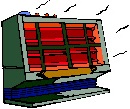
NFPA: High Energy Costs Could Result in More Home Fires
In the latest issue of the NFPA Journal, the National Fire Protection Association reminds us that heating is a leading cause of home fires and home fire deaths, with one in six home fires today caused by heating equipment. NFPA's 2007 report on home fires cited heating equipment as the cause of more than 62,000 home fires, 670 deaths, and 1,550 injuries in 2005. These fires also caused more than $900 million in property damage.
Now, in the midst of the nation's economic troubles, NFPA is concerned about a possible spike in heating-related fires because of the tremendous increase in energy costs. The association says that at other times when fuel costs have risen, it has seen a corresponding increase in heating-related fires, and with today's combination of much higher energy costs and much higher unemployment, "we fear that . . . more people who are unable to pay for heating oil or utilities [will] use more dangerous ways of heating their homes."
One of NFPA's primary concerns is that, as more people try to stay warm with fewer dollars to pay for fuel, an increased use of space heaters, especially by people unfamiliar with them, will result in more fires. The association's research shows that, while space heaters account for about one-third of the home heating fires, they account for nearly three-fourths of home heating fire deaths. The leading factor in space heater fires is placing the heater too close to things that can burn. In one particularly tragic event in Boston last winter, two young children perished when a space heater left on at night too close to them ignited their bedding.
Another major concern is that people will rely more on fireplaces and woodstoves to provide heat without taking adequate steps to make sure they are using them safely. People who have not used their fireplaces in years may now decide to light a fire before having the chimney inspected and cleaned. According to an NFPA study, chimneys and chimney connectors accounted for the largest share of home heating fires and that failure to clean accounted for two-thirds of those fires.
The association says that along with the risk of fire, it also is concerned about the dangers of carbon monoxide poisoning from devices that are not vented properly or have vents blocked by snow. Without proper, open vents, unsafe levels of this toxic gas can build up in homes, NFPA notes. "While we brace for the inevitable hardships that come with an economic downturn, it is important that we not forget that one of them is the increased risk of fire," NFPA says. "That is why we will work hard this winter to spread the prevention message so that families will be aware of the risks as they decide how to keep themselves warm this winter."